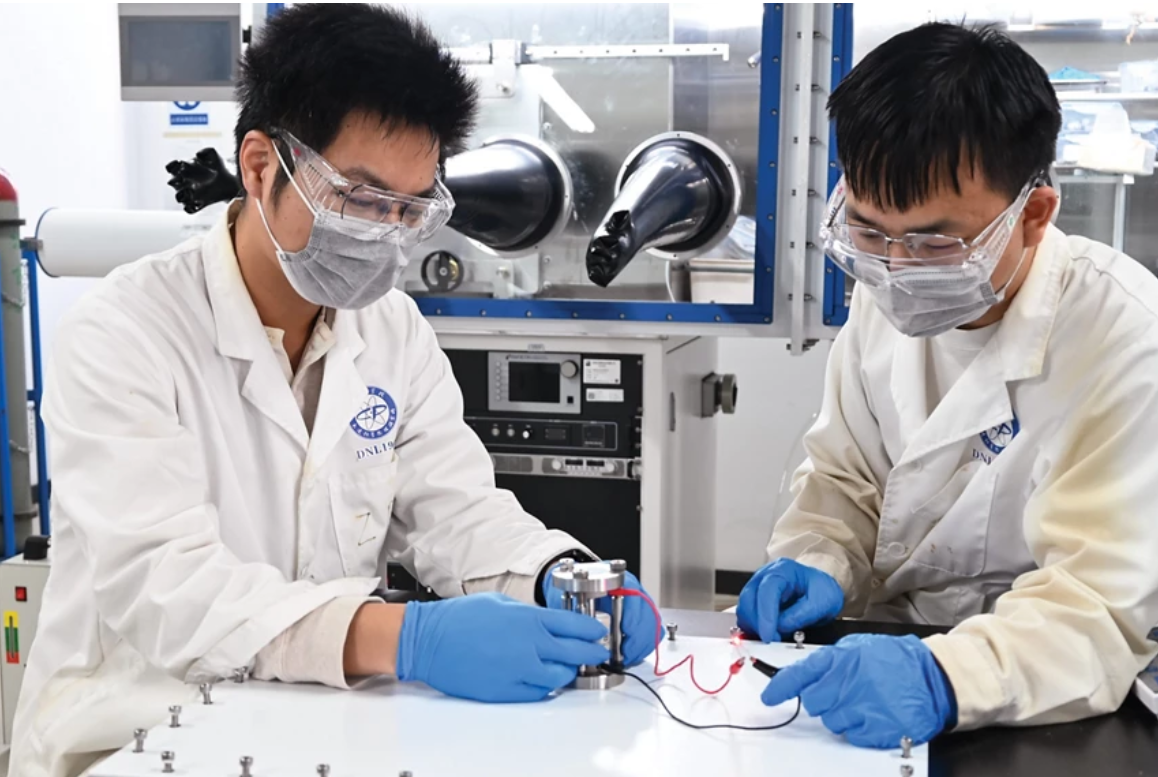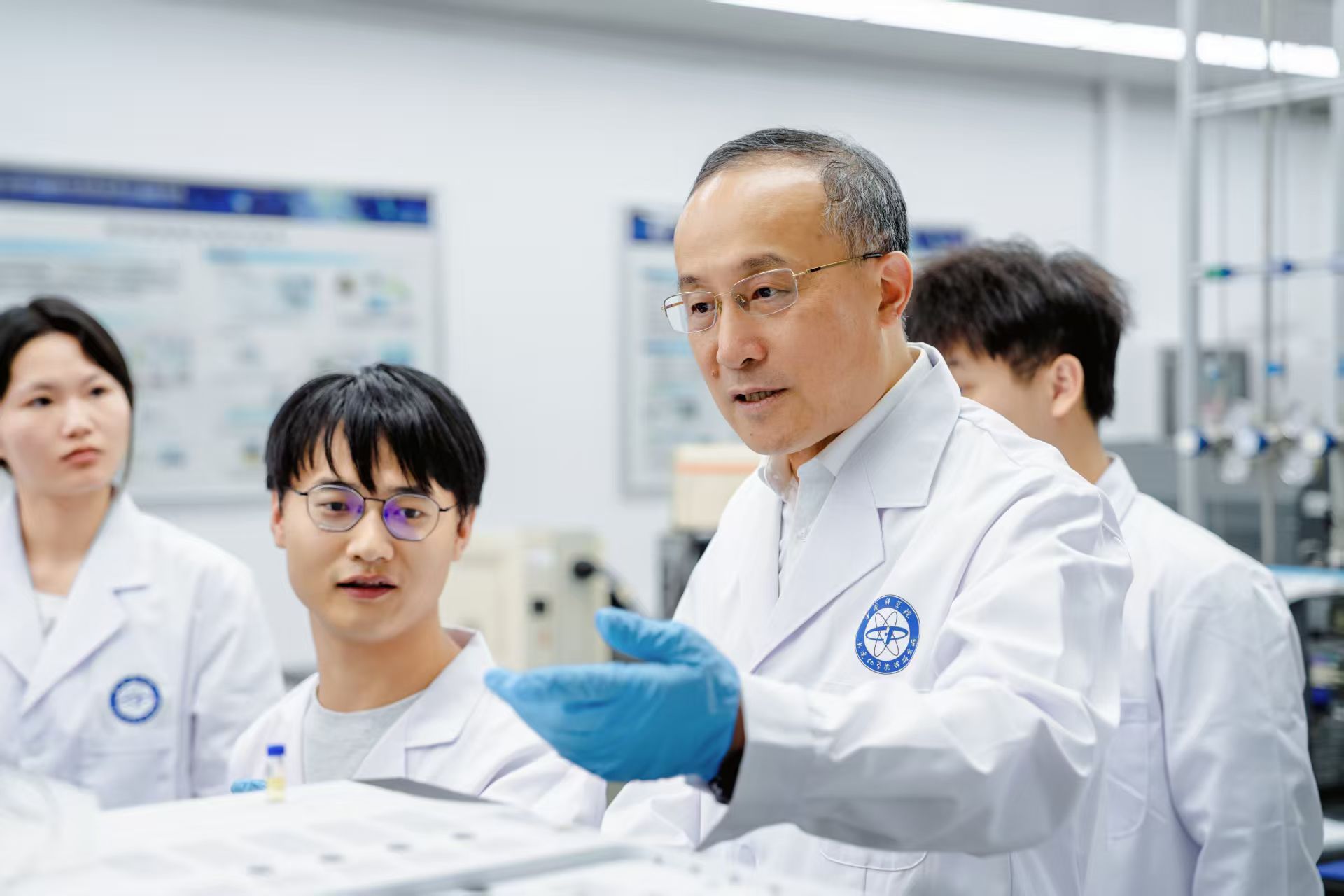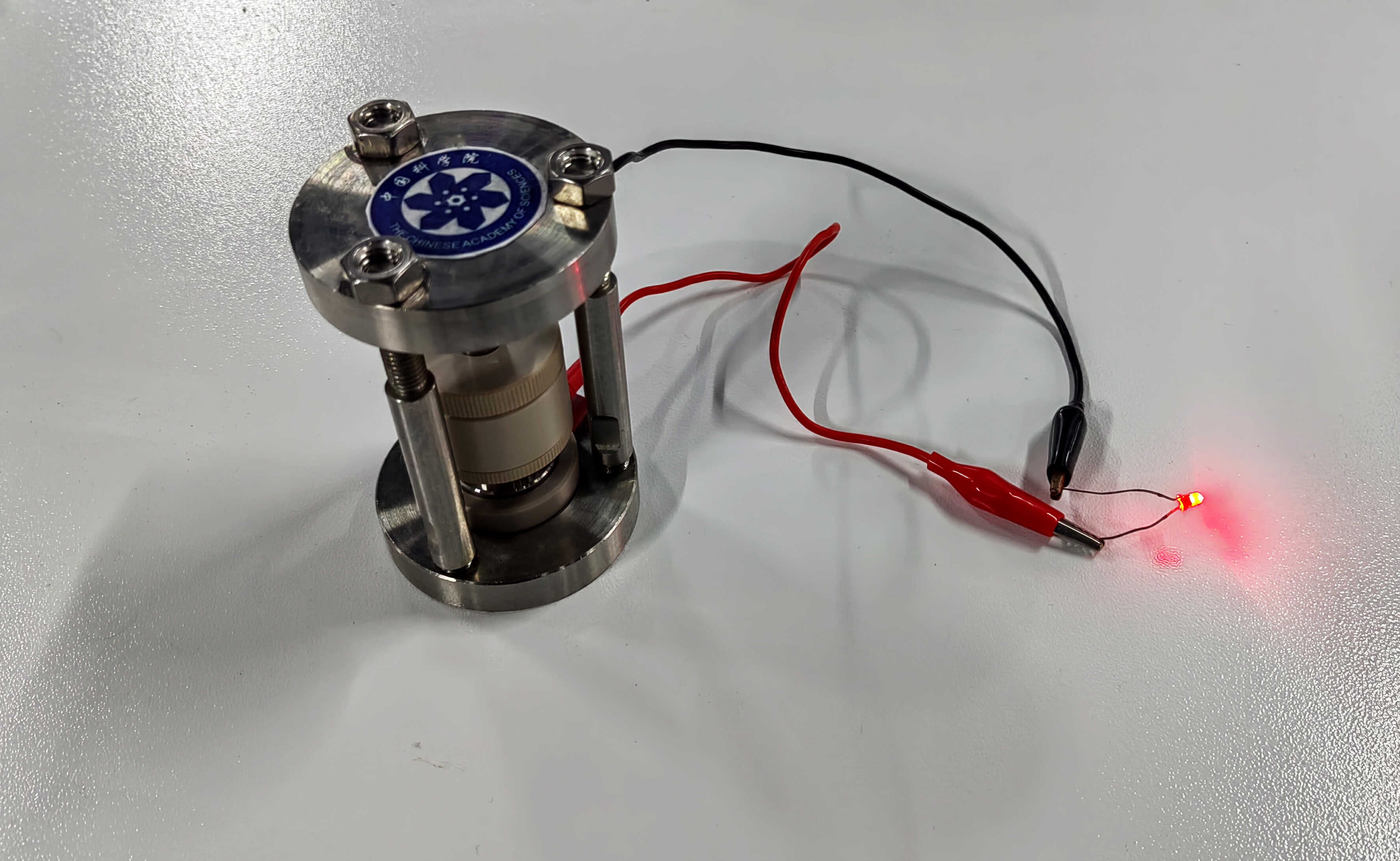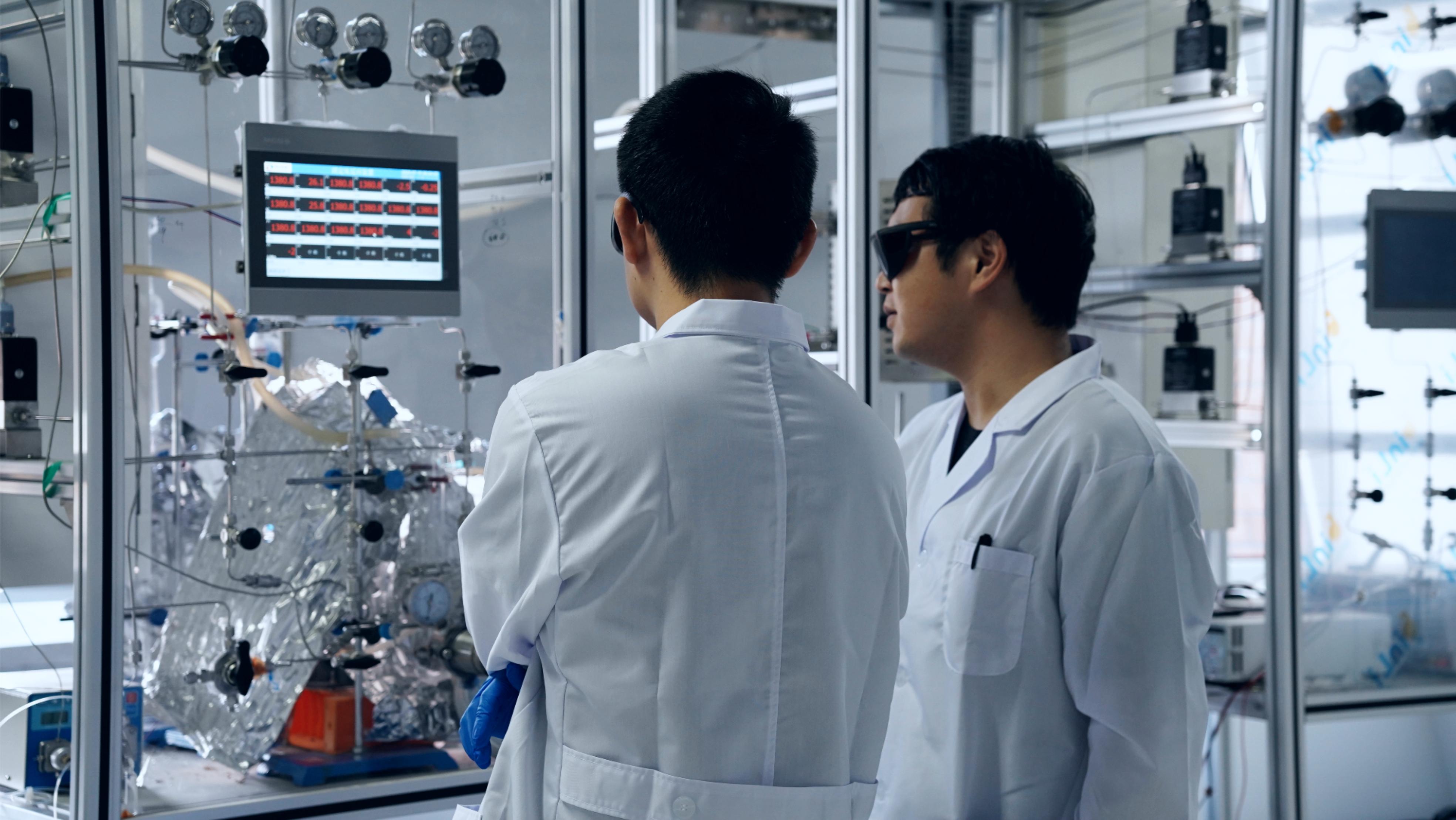DICP in Media
-
 11 15, 2025[Xinhua] Across China: Digital transformation powers upgrade of manufacturing enterprises in northeast ChinaDigital transformation is accelerating among small and medium-sized enterprises in northeast China's industrial base, aided by supportive technical service system and thriving industrial ecosystem.SHENYANG, Nov. 15 (Xinhua) -- Digital transformation is accelerating among small and medium-sized enterprises in northeast China's industrial base, aided by supportive technical service system and thriving industrial ecosystem.In Wafangdian City, a major production base for bearings in northeast China's Liaoning Province, local manufacturers are exploring digital transformation. At Jingu bearing company, where production once depended entirely on the experience of veteran workers, operations are now guided by precise data metrics."Digital transformation has elevated our production capacity and efficiency to a new level," said Zuo Tongming, owner of the company.Nearby, at another manufacturer, all product inspection data is stored and updated in real time, with comprehensive reports available on demand for analysis."We've built a fully automated digital system that streamlines the entire process from order to delivery," said Zhou Jianhong, head of the company's information department. "It intelligently breaks down production processes and schedules equipment, allowing workers to manage required materials more efficiently. For precision tasks, they can readily access technical drawings on their phones."He added that this digital transformation has increased production efficiency by 20 percent and cut operational costs by 15 percent.For a long time, the high sunk costs of digitalization -- often running into millions of yuan -- had been a major hurdle for many entrepreneurs."I lay awake at night calculating the return on investment," admitted one local business owner, acknowledging that the financial strain and unpredictable payback periods left many companies feeling hesitant.A supportive ecosystem developed by local authorities is helping to boost confidence in digital adoption. In addition to financial subsidies, the government has leveraged advanced industrial Internet platforms and tailored services for the local bearing cluster, offering end-to-end support from diagnosis to system deployment.Liaoning Province has built a comprehensive digital infrastructure system, supported by a foundation of 143,000 5G base stations that ensure full coverage in all cities and key industrial parks. The core of this infrastructure also features a blockchain network and two intelligent computing centers in Shenyang City and Dalian City, providing the critical data backbone for advanced applications.Such infrastructure development facilitates platforms that connect manufacturers with supply and demand partners. For example, at the Shenyang service center of the national digital supply chain platform for equipment manufacturing, a small components factory uploaded a 3D model and was swiftly matched with a large manufacturer located just 20 kilometers away."It's like an online shopping application for industry. Smart algorithms optimize the matching of manufacturing resources," said Li Chunwei, an operator of the center. Hundreds of local firms have successfully used the platform, shortening design cycles by 30 percent and saving customer acquisition costs by 40 percent.Breakthroughs in artificial intelligence (AI) are adding another layer of sophistication. Building on advances in domestic models like DeepSeek, Liaoning is now fostering industry-specific AI applications. For instance, researchers at the Dalian Institute of Chemical Physics recently launched a large model dedicated to the chemical industry. This model is capable of simulating complex molecular reactions, significantly reducing R&D time and optimizing production to conserve energy."Comprehensive industrial system and rich application scenarios provide an ideal foundation for developing such specialized models," said Pan Hong at digital economy research institute of Liaoning University.Looking ahead, the momentum is set to accelerate across the northeast China. In Heilongjiang Province, the digital foundation is already solidifying. As of the first quarter of 2025, 51.1 percent of industrial enterprises in the province have achieved comprehensive digitization of their key business processes.According to the plan of Jilin Province for accelerating equipment upgrading in the industrial sector, the province aims to support 1,000 demonstration projects in smart manufacturing and digital transformation by 2027, cultivating 150 digital transformation service providers, establishing 120 provincial-level smart manufacturing demonstration factories and 3 leading industrial internet platforms.From factory floors to AI models, manufacturers across northeast China are scripting a robust story of revitalization powered by digital transformation. This tech-driven upgrade goes beyond a mere efficiency boost, serving as the key to unlocking a new chapter of innovation.Related link: https://english.news.cn/20251115/1f6cc1bfd378421badaeb8a026796669/c.html
11 15, 2025[Xinhua] Across China: Digital transformation powers upgrade of manufacturing enterprises in northeast ChinaDigital transformation is accelerating among small and medium-sized enterprises in northeast China's industrial base, aided by supportive technical service system and thriving industrial ecosystem.SHENYANG, Nov. 15 (Xinhua) -- Digital transformation is accelerating among small and medium-sized enterprises in northeast China's industrial base, aided by supportive technical service system and thriving industrial ecosystem.In Wafangdian City, a major production base for bearings in northeast China's Liaoning Province, local manufacturers are exploring digital transformation. At Jingu bearing company, where production once depended entirely on the experience of veteran workers, operations are now guided by precise data metrics."Digital transformation has elevated our production capacity and efficiency to a new level," said Zuo Tongming, owner of the company.Nearby, at another manufacturer, all product inspection data is stored and updated in real time, with comprehensive reports available on demand for analysis."We've built a fully automated digital system that streamlines the entire process from order to delivery," said Zhou Jianhong, head of the company's information department. "It intelligently breaks down production processes and schedules equipment, allowing workers to manage required materials more efficiently. For precision tasks, they can readily access technical drawings on their phones."He added that this digital transformation has increased production efficiency by 20 percent and cut operational costs by 15 percent.For a long time, the high sunk costs of digitalization -- often running into millions of yuan -- had been a major hurdle for many entrepreneurs."I lay awake at night calculating the return on investment," admitted one local business owner, acknowledging that the financial strain and unpredictable payback periods left many companies feeling hesitant.A supportive ecosystem developed by local authorities is helping to boost confidence in digital adoption. In addition to financial subsidies, the government has leveraged advanced industrial Internet platforms and tailored services for the local bearing cluster, offering end-to-end support from diagnosis to system deployment.Liaoning Province has built a comprehensive digital infrastructure system, supported by a foundation of 143,000 5G base stations that ensure full coverage in all cities and key industrial parks. The core of this infrastructure also features a blockchain network and two intelligent computing centers in Shenyang City and Dalian City, providing the critical data backbone for advanced applications.Such infrastructure development facilitates platforms that connect manufacturers with supply and demand partners. For example, at the Shenyang service center of the national digital supply chain platform for equipment manufacturing, a small components factory uploaded a 3D model and was swiftly matched with a large manufacturer located just 20 kilometers away."It's like an online shopping application for industry. Smart algorithms optimize the matching of manufacturing resources," said Li Chunwei, an operator of the center. Hundreds of local firms have successfully used the platform, shortening design cycles by 30 percent and saving customer acquisition costs by 40 percent.Breakthroughs in artificial intelligence (AI) are adding another layer of sophistication. Building on advances in domestic models like DeepSeek, Liaoning is now fostering industry-specific AI applications. For instance, researchers at the Dalian Institute of Chemical Physics recently launched a large model dedicated to the chemical industry. This model is capable of simulating complex molecular reactions, significantly reducing R&D time and optimizing production to conserve energy."Comprehensive industrial system and rich application scenarios provide an ideal foundation for developing such specialized models," said Pan Hong at digital economy research institute of Liaoning University.Looking ahead, the momentum is set to accelerate across the northeast China. In Heilongjiang Province, the digital foundation is already solidifying. As of the first quarter of 2025, 51.1 percent of industrial enterprises in the province have achieved comprehensive digitization of their key business processes.According to the plan of Jilin Province for accelerating equipment upgrading in the industrial sector, the province aims to support 1,000 demonstration projects in smart manufacturing and digital transformation by 2027, cultivating 150 digital transformation service providers, establishing 120 provincial-level smart manufacturing demonstration factories and 3 leading industrial internet platforms.From factory floors to AI models, manufacturers across northeast China are scripting a robust story of revitalization powered by digital transformation. This tech-driven upgrade goes beyond a mere efficiency boost, serving as the key to unlocking a new chapter of innovation.Related link: https://english.news.cn/20251115/1f6cc1bfd378421badaeb8a026796669/c.html -
 10 09, 2025[C&EN] Introducing the hydride batteryNow researchers have developed the world's first solid-state, hydrogen-based battery that is rechargeable and works at room temperature.A new solid-state battery features an electrolyte (purple, center) sandwiched between two electrodes (blue and silver spheres). The electrolyte, which shuttles hydride ions (H–) between the electrodes, consists of a composite of cerium hydride (CeH3) and barium hydride (BaH2). The composite features particles with a core-shell structure (magnified image, right) with a CeH3 core (gray) and a BaH2 shell. Credit: Jirong Cui/Dalian Institute of Chemical PhysicsThe crisis of carbon-emissions-fueled climate change has sent humankind on a treasure hunt for cleaner sources of energy. Hydrogen, the forerunner among clean fuels, has proven difficult to tame because of the demanding conditions needed for its storage and transport. Now researchers have developed the world's first solid-state, hydrogen-based battery that is rechargeable and works at room temperature (Nature 2025, DOI: 10.1038/s41586-025-09561-3). The battery delivers electrical current by using hydrogen in the form of hydride ions to mediate power-producing electrochemical reactions.The hydride ion (H–) is a promising tool for exploiting hydrogen as an energy source. "It is a lightweight, highly reactive and polarizable, negatively charged ion," says Ping Chen, a research group leader at the Dalian Institute of Chemical Physics. Yet the absence of a suitable electrolyte that combines high H– conductivity, minimal electron leakage, thermal stability, and electrode compatibility makes practical application of H– unfeasible, Chen explains.Aiming to bypass that shortcoming, Chen and her team zeroed in on cerium hydride (CeH3) as one of the components of a solid-state electrolyte, the material needed to shuttle hydride ions throughout the battery. CeH3 shows high H– conductivity at room temperature, but the material leaks electrons severely, making it unsuitable as a battery electrolyte.Ren Zou (left) and Jirong Cui (right) of the Dalian Institute of Chemical Physics test a hydride battery by using it to power a yellow light-emitting diode. Credit: Jirong Cui/Dalian Institute of Chemical PhysicsTo remedy this problem, the researchers coated the surface of CeH3 with a thin layer of barium hydride (BaH2). That material is a relatively good H– conductor and has a wide bandgap, a property quantifying an energy range over which electrons cannot zip around and conduct electricity.They prepared a CeH3-BaH2 composite by ball milling CeH3 and BaH2 in an airtight and argon-protected environment. The resulting composite had a core-shell configuration with a 3:1 ratio of CeH3 at the core to BaH2 as the shell. The composite performed quite well at room temperature with an electronic conductivity of 3.2 × 10−6 S cm−1 and an H− conductivity of more than 10−4 S cm–1. Furthermore, the material remained electrochemically stable at temperatures just above 200 °C.Equipped with a suitable solid-state electrolyte, Chen's team sequentially stacked a CeH2 anode, the CeH3-BaH2 electrolyte, and a cathode made of NaAlH4 mixed with carbon nanotubes and TiO2. The researchers did the assembly work in an argon-filled glove box and sandwiched the layers together, forming a small tablet-like battery.The battery showed an initial specific capacity, a weight-based measure of its ability to store electrical charge, of 984 mAh g−1. After 20 charge-discharge cycles, that value fell to 402 mAh g−1. The researchers constructed a multilayer stacked battery with a combined voltage of 1.9 V, which successfully lit a light-emitting diode, proving that such a battery can power electrical devices."One unique feature of this battery is that it's free from detrimental metal dendrites commonly found in lithium- and sodium-ion batteries," Chen says. Dendrites are tiny, treelike structures made of metallic filaments (lithium or sodium) that can grow inside batteries during charging and cause dangerous short circuiting.Jay Benziger, a professor of chemical engineering at Princeton University who wasn't involved in the study, calls it "a work that could advance battery technology and capability." He says that with the right thickness and voltage, these batteries "could be potentially a replacement for lithium-ion batteries." He feels this technology "conceptually has a lot of possibilities" but has concerns about its scalability. Though cerium is quite abundant, its extraction is complex and expensive, posing a potential roadblock for the battery's mass production.Republished with permission from Chemical & Engineering News. Copyright ©2025 by the American Chemical Society. The article, "Introducing the hydride battery" was first published on October 1, 2025 at https://cen.acs.org/materials/energy-storage/Introducing-hydride-battery/103/web/2025/10
10 09, 2025[C&EN] Introducing the hydride batteryNow researchers have developed the world's first solid-state, hydrogen-based battery that is rechargeable and works at room temperature.A new solid-state battery features an electrolyte (purple, center) sandwiched between two electrodes (blue and silver spheres). The electrolyte, which shuttles hydride ions (H–) between the electrodes, consists of a composite of cerium hydride (CeH3) and barium hydride (BaH2). The composite features particles with a core-shell structure (magnified image, right) with a CeH3 core (gray) and a BaH2 shell. Credit: Jirong Cui/Dalian Institute of Chemical PhysicsThe crisis of carbon-emissions-fueled climate change has sent humankind on a treasure hunt for cleaner sources of energy. Hydrogen, the forerunner among clean fuels, has proven difficult to tame because of the demanding conditions needed for its storage and transport. Now researchers have developed the world's first solid-state, hydrogen-based battery that is rechargeable and works at room temperature (Nature 2025, DOI: 10.1038/s41586-025-09561-3). The battery delivers electrical current by using hydrogen in the form of hydride ions to mediate power-producing electrochemical reactions.The hydride ion (H–) is a promising tool for exploiting hydrogen as an energy source. "It is a lightweight, highly reactive and polarizable, negatively charged ion," says Ping Chen, a research group leader at the Dalian Institute of Chemical Physics. Yet the absence of a suitable electrolyte that combines high H– conductivity, minimal electron leakage, thermal stability, and electrode compatibility makes practical application of H– unfeasible, Chen explains.Aiming to bypass that shortcoming, Chen and her team zeroed in on cerium hydride (CeH3) as one of the components of a solid-state electrolyte, the material needed to shuttle hydride ions throughout the battery. CeH3 shows high H– conductivity at room temperature, but the material leaks electrons severely, making it unsuitable as a battery electrolyte.Ren Zou (left) and Jirong Cui (right) of the Dalian Institute of Chemical Physics test a hydride battery by using it to power a yellow light-emitting diode. Credit: Jirong Cui/Dalian Institute of Chemical PhysicsTo remedy this problem, the researchers coated the surface of CeH3 with a thin layer of barium hydride (BaH2). That material is a relatively good H– conductor and has a wide bandgap, a property quantifying an energy range over which electrons cannot zip around and conduct electricity.They prepared a CeH3-BaH2 composite by ball milling CeH3 and BaH2 in an airtight and argon-protected environment. The resulting composite had a core-shell configuration with a 3:1 ratio of CeH3 at the core to BaH2 as the shell. The composite performed quite well at room temperature with an electronic conductivity of 3.2 × 10−6 S cm−1 and an H− conductivity of more than 10−4 S cm–1. Furthermore, the material remained electrochemically stable at temperatures just above 200 °C.Equipped with a suitable solid-state electrolyte, Chen's team sequentially stacked a CeH2 anode, the CeH3-BaH2 electrolyte, and a cathode made of NaAlH4 mixed with carbon nanotubes and TiO2. The researchers did the assembly work in an argon-filled glove box and sandwiched the layers together, forming a small tablet-like battery.The battery showed an initial specific capacity, a weight-based measure of its ability to store electrical charge, of 984 mAh g−1. After 20 charge-discharge cycles, that value fell to 402 mAh g−1. The researchers constructed a multilayer stacked battery with a combined voltage of 1.9 V, which successfully lit a light-emitting diode, proving that such a battery can power electrical devices."One unique feature of this battery is that it's free from detrimental metal dendrites commonly found in lithium- and sodium-ion batteries," Chen says. Dendrites are tiny, treelike structures made of metallic filaments (lithium or sodium) that can grow inside batteries during charging and cause dangerous short circuiting.Jay Benziger, a professor of chemical engineering at Princeton University who wasn't involved in the study, calls it "a work that could advance battery technology and capability." He says that with the right thickness and voltage, these batteries "could be potentially a replacement for lithium-ion batteries." He feels this technology "conceptually has a lot of possibilities" but has concerns about its scalability. Though cerium is quite abundant, its extraction is complex and expensive, posing a potential roadblock for the battery's mass production.Republished with permission from Chemical & Engineering News. Copyright ©2025 by the American Chemical Society. The article, "Introducing the hydride battery" was first published on October 1, 2025 at https://cen.acs.org/materials/energy-storage/Introducing-hydride-battery/103/web/2025/10 -
 09 29, 2025[Xinhua] Chinese chemist wins 2025 Citation Laureates awardClarivate Analytics on Thursday announced the 2025 Citation Laureates award, which recognized 22 scholars from eight countries. Chinese chemist Zhang Tao, from Dalian Institute of Chemical Physics under the Chinese Academy of Sciences, won the award in chemistry for his contributions to single-atom catalysis, becoming the first scientist from the Chinese mainland to receive the Citation Laureates award.BEIJING, Sept. 25 (Xinhua) -- Clarivate Analytics on Thursday announced the 2025 Citation Laureates award, which recognized 22 scholars from eight countries. Chinese chemist Zhang Tao, from Dalian Institute of Chemical Physics under the Chinese Academy of Sciences, won the award in chemistry for his contributions to single-atom catalysis, becoming the first scientist from the Chinese mainland to receive the Citation Laureates award.Zhang, along with his collaborators, created the concept of single-atom catalysis, which advances heterogeneous catalysis research to the atomic level, laying the scientific foundation for precise catalysis, and opening up an entirely new frontier in the field.His groundbreaking research has not only driven fundamental advances in catalysis science but also profoundly influenced several frontier interdisciplinary fields, including energy chemistry and materials science. His research has further stimulated rapid global progress in this field of research.The Citation Laureates award is granted based on a comprehensive evaluation of research impact, including citation performance, originality, breakthrough significance, identification of core contributors, and peer recognition.Widely regarded as a leading "predictor" of the Nobel Prizes, the Citation Laureate award has seen 83 of its past recipients go on to win Nobel Prizes since its inception.Related link: https://english.news.cn/20250925/748d596e65a54f47b3aa897ab2cf8cd0/c.html
09 29, 2025[Xinhua] Chinese chemist wins 2025 Citation Laureates awardClarivate Analytics on Thursday announced the 2025 Citation Laureates award, which recognized 22 scholars from eight countries. Chinese chemist Zhang Tao, from Dalian Institute of Chemical Physics under the Chinese Academy of Sciences, won the award in chemistry for his contributions to single-atom catalysis, becoming the first scientist from the Chinese mainland to receive the Citation Laureates award.BEIJING, Sept. 25 (Xinhua) -- Clarivate Analytics on Thursday announced the 2025 Citation Laureates award, which recognized 22 scholars from eight countries. Chinese chemist Zhang Tao, from Dalian Institute of Chemical Physics under the Chinese Academy of Sciences, won the award in chemistry for his contributions to single-atom catalysis, becoming the first scientist from the Chinese mainland to receive the Citation Laureates award.Zhang, along with his collaborators, created the concept of single-atom catalysis, which advances heterogeneous catalysis research to the atomic level, laying the scientific foundation for precise catalysis, and opening up an entirely new frontier in the field.His groundbreaking research has not only driven fundamental advances in catalysis science but also profoundly influenced several frontier interdisciplinary fields, including energy chemistry and materials science. His research has further stimulated rapid global progress in this field of research.The Citation Laureates award is granted based on a comprehensive evaluation of research impact, including citation performance, originality, breakthrough significance, identification of core contributors, and peer recognition.Widely regarded as a leading "predictor" of the Nobel Prizes, the Citation Laureate award has seen 83 of its past recipients go on to win Nobel Prizes since its inception.Related link: https://english.news.cn/20250925/748d596e65a54f47b3aa897ab2cf8cd0/c.html -
 09 29, 2025[Chinadaily] Chinese chemist wins intl awardChinese chemist Zhang Tao, a pioneer in single-atom catalysis, has become the first Citation Laureate from the Chinese mainland for research that enables more efficient, sustainable chemical reactions and offers solutions for a cleaner, greener world.Chinese chemist Zhang Tao, a pioneer in single-atom catalysis, has become the first Citation Laureate from the Chinese mainland for research that enables more efficient, sustainable chemical reactions and offers solutions for a cleaner, greener world.Selected by analytics company Clarivate, the international award recognizes research influence and citation impact comparable to that of Nobel Prize recipients. Since the program's inception in 2002, 83 of more than 460 laureates have later been awarded a Nobel Prize.Clarivate announced this year's 22 laureates in physiology or medicine, physics, chemistry and economics during a launch ceremony in Beijing on Thursday. The winners are affiliated with academic institutions and universities in eight countries.Zhang, an academician of the Chinese Academy of Sciences and a researcher at the Dalian Institute of Chemical Physics, is renowned for the transformative technology of single-atom catalysis, which contributes to the sustainability of chemical processes, energy conversion and environmental cleanup.In 2011, Zhang and his team published a landmark paper in the journal Nature Chemistry reporting the creation of a single-atom catalyst on an iron oxide support.The findings revolutionized heterogeneous catalysis by overturning the conventional wisdom that a single atom would be unstable under catalytic conditions. The work also established a systematic methodology for other researchers.The paper has since been cited more than 6,000 times in the Web of Science database."It ranks in the top 2,000 we have indexed in any field since 1970, and the top 500 for contributions from 2011 to the present," said David Pendlebury, chief scientist at Clarivate's Institute for Scientific Information."The paper, as they say, launched a thousand ships steered by other researchers now eager to explore the new territory that Zhang and his colleagues charted," he said.Zhang said the award represents full recognition of the originality and international impact of the research."In the past, my collaborators and I created the concept of single-atom catalysis by standing on the shoulders of others. Looking ahead, I hope that more young scientists will stand on our shoulders to drive catalysis and chemistry to a higher level," he said."I believe that the integration of single-atom catalysis with artificial intelligence will shape a new paradigm of atomically precise catalysis, making rational catalyst design possible and accelerating the advancement of global new energy and green chemical industries," he added.Osher Gilinsky, vice-president of Clarivate, said Zhang's selection as the first Citation Laureate from the Chinese mainland reflects the country's growing influence in global science."Over the past decade, we have witnessed the tremendous progress China has made and continues to make in research and development," he said.He noted that according to the company's annual reports evaluating the research and innovation prowess of G20 nations, the Chinese mainland led research output with nearly 900,000 papers — tripling its volume since 2015."By honoring scientists like Zhang Tao, we help shine a light on discoveries that improve life and shape our future," he said.Related link: http://https://global.chinadaily.com.cn/a/202509/26/WS68d5e65fa3108622abca30a0.html
09 29, 2025[Chinadaily] Chinese chemist wins intl awardChinese chemist Zhang Tao, a pioneer in single-atom catalysis, has become the first Citation Laureate from the Chinese mainland for research that enables more efficient, sustainable chemical reactions and offers solutions for a cleaner, greener world.Chinese chemist Zhang Tao, a pioneer in single-atom catalysis, has become the first Citation Laureate from the Chinese mainland for research that enables more efficient, sustainable chemical reactions and offers solutions for a cleaner, greener world.Selected by analytics company Clarivate, the international award recognizes research influence and citation impact comparable to that of Nobel Prize recipients. Since the program's inception in 2002, 83 of more than 460 laureates have later been awarded a Nobel Prize.Clarivate announced this year's 22 laureates in physiology or medicine, physics, chemistry and economics during a launch ceremony in Beijing on Thursday. The winners are affiliated with academic institutions and universities in eight countries.Zhang, an academician of the Chinese Academy of Sciences and a researcher at the Dalian Institute of Chemical Physics, is renowned for the transformative technology of single-atom catalysis, which contributes to the sustainability of chemical processes, energy conversion and environmental cleanup.In 2011, Zhang and his team published a landmark paper in the journal Nature Chemistry reporting the creation of a single-atom catalyst on an iron oxide support.The findings revolutionized heterogeneous catalysis by overturning the conventional wisdom that a single atom would be unstable under catalytic conditions. The work also established a systematic methodology for other researchers.The paper has since been cited more than 6,000 times in the Web of Science database."It ranks in the top 2,000 we have indexed in any field since 1970, and the top 500 for contributions from 2011 to the present," said David Pendlebury, chief scientist at Clarivate's Institute for Scientific Information."The paper, as they say, launched a thousand ships steered by other researchers now eager to explore the new territory that Zhang and his colleagues charted," he said.Zhang said the award represents full recognition of the originality and international impact of the research."In the past, my collaborators and I created the concept of single-atom catalysis by standing on the shoulders of others. Looking ahead, I hope that more young scientists will stand on our shoulders to drive catalysis and chemistry to a higher level," he said."I believe that the integration of single-atom catalysis with artificial intelligence will shape a new paradigm of atomically precise catalysis, making rational catalyst design possible and accelerating the advancement of global new energy and green chemical industries," he added.Osher Gilinsky, vice-president of Clarivate, said Zhang's selection as the first Citation Laureate from the Chinese mainland reflects the country's growing influence in global science."Over the past decade, we have witnessed the tremendous progress China has made and continues to make in research and development," he said.He noted that according to the company's annual reports evaluating the research and innovation prowess of G20 nations, the Chinese mainland led research output with nearly 900,000 papers — tripling its volume since 2015."By honoring scientists like Zhang Tao, we help shine a light on discoveries that improve life and shape our future," he said.Related link: http://https://global.chinadaily.com.cn/a/202509/26/WS68d5e65fa3108622abca30a0.html -
 09 18, 2025[Xinhua] Chinese scientists develop first hydride ion prototype batteryA team of Chinese scientists has developed the first hydride ion prototype battery, laying a solid foundation for China's green energy development. The team's findings were published on Wednesday in the journal Nature.DALIAN, Sept. 18 (Xinhua) -- A team of Chinese scientists has developed the first hydride ion prototype battery, laying a solid foundation for China's green energy development. The team's findings were published on Wednesday in the journal Nature.Considered an important part of the future clean energy system, hydrogen typically participates in reactions in the form of protons, hydride ions and hydrogen atoms. Among these, hydride ions have the highest electron density, while they are easily polarized and highly reactive -- making them a promising energy carrier. The hydride ion battery is an important research direction in the field of clean energy.Similar to the widely used lithium-ion battery, a hydride ion battery uses the movement of hydride ions to store and release energy. However, the battery was previously confined to the conceptual stage due to a lack of appropriate electrolyte materials, which should possess high ionic conductivity, low electronic conductivity, good thermal and electrochemical stability, and compatibility with electrode materials.The research team led by Chen Ping, Cao Hujun and Zhang Weijin, all from the Dalian Institute of Chemical Physics, located in northeast China's Liaoning Province and affiliated to the Chinese Academy of Sciences, has invented a new core-shell structured composite hydride which serves as the electrolyte material.This composite is composed of a thin layer of barium hydride coated on cerium trihydride. It exhibits good hydride ion conduction properties at room temperature, along with excellent thermal and electrochemical stability -- making it an ideal electrolyte material.The team successfully achieved charging and discharging by using sodium aluminum hydride, a hydrogen storage material, as the positive electrode, and hydrogen-poor cerium dihydride as the negative electrode. The team also built a stacked battery based on this configuration, increasing the voltage to 1.9 volts and lighting up an LED light.These findings, notably, prove the feasibility of the hydride ion battery for powering electronic devices -- and mark its leap from the conceptual stage to experimental verification.According to the study, the hydride ion battery represents a brand new technical route of energy storage which is expected to play an important role in fields such as large-scale energy storage, hydrogen storage, mobile power sources and special power sources.The team said it will focus on the development of hydride ion battery core materials and the optimization of their performance -- and expand the battery's application scenarios to provide strong support for China's green energy development.Related link: https://english.news.cn/20250918/03bb1f7428384e3ab98225c04ddd5e21/c.html
09 18, 2025[Xinhua] Chinese scientists develop first hydride ion prototype batteryA team of Chinese scientists has developed the first hydride ion prototype battery, laying a solid foundation for China's green energy development. The team's findings were published on Wednesday in the journal Nature.DALIAN, Sept. 18 (Xinhua) -- A team of Chinese scientists has developed the first hydride ion prototype battery, laying a solid foundation for China's green energy development. The team's findings were published on Wednesday in the journal Nature.Considered an important part of the future clean energy system, hydrogen typically participates in reactions in the form of protons, hydride ions and hydrogen atoms. Among these, hydride ions have the highest electron density, while they are easily polarized and highly reactive -- making them a promising energy carrier. The hydride ion battery is an important research direction in the field of clean energy.Similar to the widely used lithium-ion battery, a hydride ion battery uses the movement of hydride ions to store and release energy. However, the battery was previously confined to the conceptual stage due to a lack of appropriate electrolyte materials, which should possess high ionic conductivity, low electronic conductivity, good thermal and electrochemical stability, and compatibility with electrode materials.The research team led by Chen Ping, Cao Hujun and Zhang Weijin, all from the Dalian Institute of Chemical Physics, located in northeast China's Liaoning Province and affiliated to the Chinese Academy of Sciences, has invented a new core-shell structured composite hydride which serves as the electrolyte material.This composite is composed of a thin layer of barium hydride coated on cerium trihydride. It exhibits good hydride ion conduction properties at room temperature, along with excellent thermal and electrochemical stability -- making it an ideal electrolyte material.The team successfully achieved charging and discharging by using sodium aluminum hydride, a hydrogen storage material, as the positive electrode, and hydrogen-poor cerium dihydride as the negative electrode. The team also built a stacked battery based on this configuration, increasing the voltage to 1.9 volts and lighting up an LED light.These findings, notably, prove the feasibility of the hydride ion battery for powering electronic devices -- and mark its leap from the conceptual stage to experimental verification.According to the study, the hydride ion battery represents a brand new technical route of energy storage which is expected to play an important role in fields such as large-scale energy storage, hydrogen storage, mobile power sources and special power sources.The team said it will focus on the development of hydride ion battery core materials and the optimization of their performance -- and expand the battery's application scenarios to provide strong support for China's green energy development.Related link: https://english.news.cn/20250918/03bb1f7428384e3ab98225c04ddd5e21/c.html -
 09 08, 2025[Xinhua] Breakthrough in hydrogen dissociation offers new hope for carbon emission reductionScientists have made a significant advancement in the field of photocatalytic hydrogen dissociation, offering a promising pathway to more sustainable chemical manufacturing with lower energy use and reduced environmental impact.BEIJING, Sept. 5 (Xinhua) -- Scientists have made a significant advancement in the field of photocatalytic hydrogen dissociation, offering a promising pathway to more sustainable chemical manufacturing with lower energy use and reduced environmental impact.The study, led by researchers from the Dalian Institute of Chemical Physics (DICP) of the Chinese Academy of Sciences and the University of Trieste in Italy, was published in the latest issue of the journal Science. It demonstrates a new method to dissociate hydrogen molecules under mild conditions -- specifically, at room temperature and with the use of light.Hydrogenation reactions are crucial in the chemical industry, involved in approximately one-quarter of all chemical processes. A key step in these reactions is hydrogen activation, which can occur through two mechanisms: homolytic and hydrogen dissociation. The latter can lead to faster production of important chemicals and fewer unwanted by-products. However, until now, this type of dissociation typically required high temperature and pressure, consuming large amounts of energy and posing safety risks.The research team developed a novel photocatalytic strategy that was able to overcome previous limitations. Instead of using photo-generated electrons and holes separately to drive half-reactions, they used them together to create spatially adjacent positive and negative charge centers, enabling hydrogen heterolysis at room temperature."Using hydrogen and carbon dioxide to produce high-value chemicals such as ethane and ethylene can greatly reduce the energy consumption of traditional hydrogenation processes and cut carbon emissions," said Wang Feng, a professor at DICP."It also helps optimize the use of carbon resources," he added.Wang said that the team will continue to develop the process toward industrial application, combining light and heat to potentially modernize and decarbonize coal-based chemical production.Related link: https://english.news.cn/20250905/05e328e4fd1141dbaf71e0566a32f0ad/c.html
09 08, 2025[Xinhua] Breakthrough in hydrogen dissociation offers new hope for carbon emission reductionScientists have made a significant advancement in the field of photocatalytic hydrogen dissociation, offering a promising pathway to more sustainable chemical manufacturing with lower energy use and reduced environmental impact.BEIJING, Sept. 5 (Xinhua) -- Scientists have made a significant advancement in the field of photocatalytic hydrogen dissociation, offering a promising pathway to more sustainable chemical manufacturing with lower energy use and reduced environmental impact.The study, led by researchers from the Dalian Institute of Chemical Physics (DICP) of the Chinese Academy of Sciences and the University of Trieste in Italy, was published in the latest issue of the journal Science. It demonstrates a new method to dissociate hydrogen molecules under mild conditions -- specifically, at room temperature and with the use of light.Hydrogenation reactions are crucial in the chemical industry, involved in approximately one-quarter of all chemical processes. A key step in these reactions is hydrogen activation, which can occur through two mechanisms: homolytic and hydrogen dissociation. The latter can lead to faster production of important chemicals and fewer unwanted by-products. However, until now, this type of dissociation typically required high temperature and pressure, consuming large amounts of energy and posing safety risks.The research team developed a novel photocatalytic strategy that was able to overcome previous limitations. Instead of using photo-generated electrons and holes separately to drive half-reactions, they used them together to create spatially adjacent positive and negative charge centers, enabling hydrogen heterolysis at room temperature."Using hydrogen and carbon dioxide to produce high-value chemicals such as ethane and ethylene can greatly reduce the energy consumption of traditional hydrogenation processes and cut carbon emissions," said Wang Feng, a professor at DICP."It also helps optimize the use of carbon resources," he added.Wang said that the team will continue to develop the process toward industrial application, combining light and heat to potentially modernize and decarbonize coal-based chemical production.Related link: https://english.news.cn/20250905/05e328e4fd1141dbaf71e0566a32f0ad/c.html